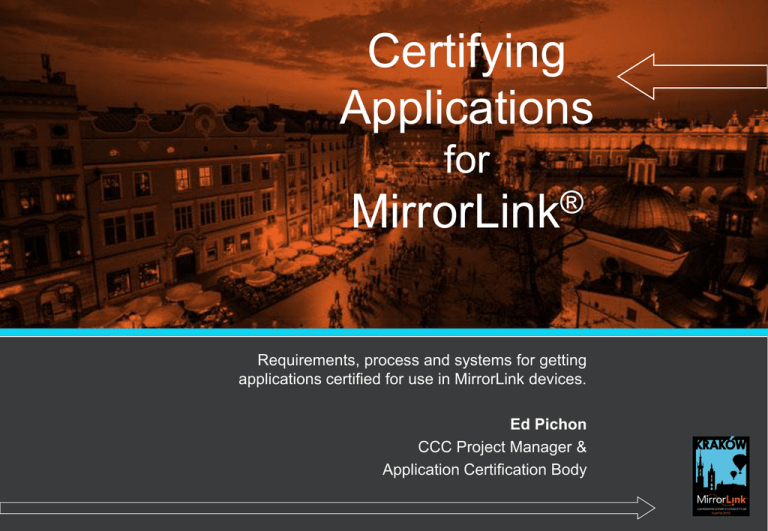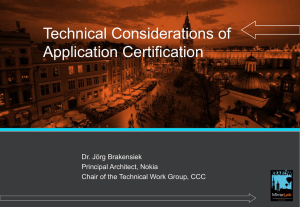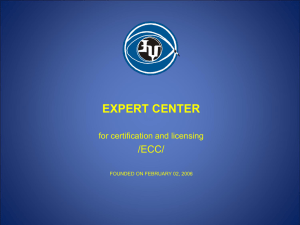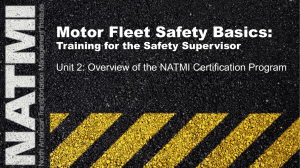Certifying Applications for MirrorLink
advertisement

Certifying Applications for MirrorLink® Requirements, process and systems for getting applications certified for use in MirrorLink devices. Ed Pichon CCC Project Manager & Application Certification Body Certifying Apps for MirrorLink • What is MirrorLink? • What is Certification? • How Do I Make A MirrorLink App? • Why Certify My App? • How Do I Certify My App? What is MirrorLink? High Level Overview for Application Developers • New Environment for Applications Application • Application Executed on Phone • Known challenges for development MirrorLink Common API MirrorLink Server MirrorLink Server MirrorLink Server (Phone) (Phone) (Phone) • MirrorLink Client Environment • Wide range of display sizes & capabilities • Different control schemes – rotary, single-touch screens, multi-touch screens • Different sets of available hardware keys • MirrorLink Session Environment • Remote framebuffer, scaling, audio streaming MirrorLink Client MirrorLink Client MirrorLink Client (Head Unit) (Head Unit) (Head Unit) • Communication of status and events • Data services What is Certification? High-Level Overview of Application Certification • Risk Reduction – Reduce Risk that Application Doesn’t Work • CCC Publishes Requirements for Applications • Base Certification – Does it work in MirrorLink session? • Regional Drive Certification – Does it (not) distract the driver? • Testing Performed by CCC Approved Test Labs • Does the application comply with the CCC’s requirements? • CCC Approves Applications for Use in MirrorLink • Certified Applications Can Use MirrorLink Logo & Certification Mark in their Application & in their App’s Promotional Material Goal: Create Ecosystem of Trusted Apps How Do I Make a MirrorLink App? MirrorLink Common API Making MirrorLink Apps How do I make my app work with MirrorLink? • Become MirrorLink Aware Application • Provide application metadata via self-signed certificate • Remote framebuffer, scaling, audio streaming and control mapping transparent to application • Use the MirrorLink Common API • Update application metadata MirrorLink Common API MirrorLink Server MirrorLink Server MirrorLink Server (Phone) (Phone) (Phone) MirrorLink Client MirrorLink Client MirrorLink Client (Head Unit) (Head Unit) (Head Unit) • Discover capabilities of MirrorLink Client • Respond to status messages from MirrorLink Client • Virtual keyboard and controls • Take advantage of data services MirrorLink Common API Standard MirrorLink Server Application Interface • Each Platform has Platform-Specific ML Common API Definition • • Android Common API defined Other platforms pending • Each Server Device Maker is Responsible for Implementing the ML Common API • Device Certification Tests for Common API Functionality and Compliance • • Common API test cases Common API test application Common API Section Obligation Common API Info Mandatory Device Info Mandatory Certification Info Mandatory Connection Info Mandatory Display Info Mandatory Event Info Mandatory Client Virtual Keyboard Optional Key Event Listing Optional Context Information Mandatory Device Status Info Mandatory Data Services Optional Notifications Optional MirrorLink Does Not Create Compatibility Problems MirrorLink Common API Example Common API Definition • Event Configuration Information • Obtain information about the events supported by the MirrorLink Session Feature Name Description Type Knob Support Supported knob events from the MirrorLink Client. Bit mask as defined in the VNC specification. uint32 Device Key Support Supported device key events from the MirrorLink Client. Bit mask as defined in the VNC specification. uint32 Multimedia Key Support Supported multimedia key events from the MirrorLink Client. Bit mask as defined in the VNC specification. uint32 Function Key Support ITU Key Support Number of supported function keys from the MirrorLink Client. Support for ITU keys from the MirrorLink Client uint8 bool Touch event support Number of simultaneous touch events, supported from the MirrorLink Server and Client: None, Single, Multi uint8 Pressure Mask The pressure mask indicates how many pressure levels can be distinguished from the MirrorLink Server and Client. uint8 • Event Configuration Callback • Notification to application if the Event Configuration Information has changed Why Certify My Application? Base and Regional Drive Certifications Types of Certification & Benefits • No Certification – No Guarantee of Availability in MirrorLink Session • ML Server (phone) may not advertise application to the ML Client • ML Client (head unit) may not present application to User • Base Certification – Guaranteed Availability While Not Driving • ML Server required to advertise the application to the ML Client • ML Client required to list application to user while not driving • Drive Certification – Guaranteed Availability While Driving (Per Region) • ML Server required to advertise the application to the ML Client • ML Client required to present application to user while driving • Certified Applications Listed and Promoted by CCC • Use MirrorLink logo & certification mark in application promotional materials Base Certification Basic Interoperability Display Compatibility • Support Reference Client Display • 800 x 480 pixels (square) • 13.33 cm x 8.00 cm • 90 cm from driver • Adapt to Client Display [Optional] • Support Landscape Mode • Control Positioning • Not entirely within outer 5% of the display Control Compatibility • Support Rotary Knobs • May not have a rotary keyboard available, so either implement your own, or don’t require • Support Single-Touch Events • Cannot require multi-touch • Voice Commands • • May use, but may not be available Must notify user if not available • Cannot Require OS Keys • May not be present on Client • Provide Application Metadata Benefit – App Will Work With ML Clients Base Certification Application Metadata • Provide Information to the ML Client About the Application • • • Application type Framebuffer context information – visual content categories Audio stream context information – audio content categories • ML Client Uses Information To Determine What Has Priority • Application Types • • Long list of types Can be provided on a per-screen area basis • Visual Content Categories • • Text, Video, Image, Vector Graphics, 3D Graphics, User Interface (e.g. Application menu), Miscellaneous Content Can be provided on a per-screen area basis • Audio Content Categories • Phone Audio, Media Audio Out, Media Audio In, Voice Command Out, Voice Command In, Miscellaneous Content App Category Navigation Visual Content Category Vector Graphics App Category – General UI Framework Visual Content Category – Vector Graphics Drive Certification Minimizing Driver Distraction • Guiding Principals • • Nothing that demands the driver’s attention Quickly comprehendible and accessible • Restricted Content • • No video, incidental animations or flashing No automatic scrolling text Region-Based Certification • • Visual Accessibility • • Color contrast – brightness & color differences Text legibility • • Minimum height Font requirements • • Control Accessibility • • • No two-handed operations Should not use the keyboard Control sizing and spacing • Pace of Interaction • • Input retention and responsiveness Notification dismissal • Region Specific • North America • European Union • APAC Global Certification • Superset of NA, EU and APAC guidelines • Pending Can Get Certified for One or Multiple Regions • E.g. Drive in EU & APAC, but not NA How Do I Certify My Application? Application Certificates and the ACMS MirrorLink Application Certificates • X590v3 Certificate • Signed by the the CCC’s Root Certificate Authority • Contains MirrorLink XML Extension • MirrorLink XML Extension • Descriptive information about the application • Information on how to list application on MirrorLink Client • Content categories • Base certification regions • Drive certification regions • Generated & Distributed by the CCC <appIdentifier>ACMSDemo1234abcd</appIdentifier> <appListEntry> <name>ACMS Demo 1</name> <providerName>E-Qualus</providerName> <providerURL>www.e-qualus.com</providerURL> <description>A demo app.</description> <iconList> <icon> <mimetype>image/png</mimetype> <width>72</width> <height>72</height> <depth>24</depth> <url>/resources/icon.png</url> </icon> </iconList> <appInfo> <appCategory>0x00080000</appCategory> </appInfo> . . . Application Certificate Management System ACMS for App Developers Car Connectivity Consortium App Certificate Management System Certificate Distribution App & Dev Certificates Device Makers Management Portal Certification Body Application Certificates distributed to server devices over the Internet. Test Labs Developers Apps MirrorLink® Server Devices App Stores Phones & other mobile devices Apps MirrorLink® Client Devices Head unitsApp Certificate tells Servers & Clients when the app is safe to use, and where. Apps do not contain Application Certificates. ACMS Integration Requires No Changes to Application 16 Application Life Cycle • Standard Application • No MirrorLink functionality • MirrorLink Aware Application • Indicates to Server that app MAY have a certificate provided by the ACMS • Indicated to Server in platform-specific fashion • Android – Include self-signed certificate in APK, bind to MirrorLink API intents • MirrorLink Server will check with the ACMS for an application certificate • MirrorLink Certified Standard Application MirrorLink Aware Application May have a Certificate on the ACMS Platform-specific indication. MirrorLink Certified Application Certificate provided by the ACMS • Certificate available from the ACMS MirrorLink Aware Apps Can Become Certified At Any Time Application Certificate Updates • MirrorLink Servers Periodically Check With ACMS • Checks for to see if any application certificates have been updated • Check frequency controlled by ACMS • ~7 days, initial rate • Certificate Update Process • Revoke existing certificate • Issue a new certificate • MirrorLink Server downloads new certificate from ACMS Application Perspective • Can Distribute Application Prior to Certification • When certification is granted, MirrorLink Servers will automatically download application certificate when it becomes available • Changes to Certification Status Do Not Require Changes to Application • Certificate is updated and distributed to devices in the field Application ID & Security • Identifies an App to the ACMS • “Do you have a certificate for an app with this App ID?” • How the App ID is Generated is Platform Specific • In general, a hash of the application files • Android – Hash of the contents of the Android Manifest • Anytime the Application is Updated, the App ID Changes • Updates to the application cause the App ID to change • MirrorLink Server Checks That the App ID in the Certificate Matches the App ID of the Application Ensures That Running App is the Application that Was Certified Developer Certificates Testing Application Behavior 1. Developer Requests a Developer Certificate via ACMS Portal • Provides IMEI to ACMS SMP • Provides IDs of Server devices • ACMS generates Developer ID 2. Developer Inputs Developer ID into MirrorLink Server Device • Server device requests developer certificate from ACMS 3. Developer Provides MirrorLink XML Extension in Application • Self-signed certificate (typical) 4. MirrorLink Server Presents MirrorLink XML Extension Provided By Developer As CCC-Signed ACMS Developer Certificate(s) Status Query Developer ID, Server Device IDs, Manufacturer Blacklist ML Client Device Manufacturer Name Developer IDs, Server Device ID MirrorLink™ Server Device Input Developer ID(s) Device ID(s) Dev-Signed Application Certificate Server Device IDs Developer Run Uncertified App In Drive Mode Developer ID How Do I Certify My Application? Application Certification Process Application Certification High-Level Overview (Redux) • CCC Approves Applications for Use in MirrorLink • Base Certification – Does it work? • Drive Certification – Does it distract the driver? • Testing Performed by CCC Approved Test Labs • Does the application comply with the relevant requirements? • MirrorLink Servers (Phones) Provided Certification Status Information for Installed, Certified Applications • Applies for specific version of the app on a given server platform • Certified Applications Can Use MirrorLink Logo & Certification Mark in their Application and in their Applications Promotional Material Goal – Create Ecosystem of Trusted Apps Certification Process Overview Key Elements • CCC Authorized Application Test Lab (ATL) • Approved by the CCC to perform testing • • • • Demonstrated capability to perform needed testing Periodically audited by CCC lab manager List maintained by CCC Application developer arranges testing directly with the ATL • Application Certification Body • • • Assesses application and test reports Approves/rejects apps for certification based on requirements & testing results Assesses requests to change application certification status • • Examines changes to application and application certification requirements May call for additional testing or re-testing on a case-by-case basis • Protocol Implementation Conformance Statement (PICS) • • Statement of what the application does Used to determine what tests to run Certification Process Diagram New Application Certification Developer Decides to Get App Certified Test Lab Performs Tests Developer Fills Out PICS & Submit Certification Request Testing Complete? Yes Test Lab Issues Report Certification Body Reviews Application CB Reviews Report No Ready to Test? Yes No Developer Makes Changes to App No Approve Certification? Yes ACMS Certificate Issued Engineering Change Orders ECO Process • Applications Change All the Time • Certification status needs to be changed • Application ID changed, so a new certificate is needed • Don’t Want to Retest the Application Every Time There is an Update • Instead, We Use an ECO Process • Inform CCC of the change to the app • App CB determines if re-testing is needed ECO Process Reduces Testing Burden, & Allows For Updating of Applications ECO Process Flow Test Lab Performs Tests Developer Updates App or Certification Developer Submits Request for New/Updated Certificate on ACMS Portal Testing Complete? Certification Body Reviews Change Request Testing Needed? No Yes Yes Test Lab Issues Report CB Reviews Report No Developer Makes Changes to App No Approve Change? Yes ACMS Certificate Updated Member-Certified Applications Alternative Certification for Applications • CCC Member Companies Can Certify Applications • • Application will be considered certified on MirrorLink Clients from that Member Company Not required to be available on Clients from other Member Companies, and probably will not be available • Uses ACMS-Distributed Certificates • Certifying entity is listed as Member Company, rather than CCC • Multiple Member-Certifications Possible • • • Can have multiple certifying entities listed, including CCC and member companies Allows for member companies to “extend” application operation for their Clients – e.g. add drive-mode operation Member certification can be tailored to specific vehicle models (vendor specific) • Member Company Controls Parameters of MemberCertification • Blacklisting Possible, But Only Under Exceptional Circumstances Developer Resources Aids for MirrorLink Application Developers Developer Portal & Forum • Specifications • • Requirements for applications Test specifications • Whitepapers & “How Tos” • • • • Requirements guidelines How to comply with requirements Information on MirrorLink protocol FAQs • Developer Forum • • Community support Ask questions of CCC • Developer Tools • Sample Code Certificate and Application ID Generation • Application MirrorLink XML Extension Generator • Assist in creating XML that is placed in Application Certificates • ACMS-Generated certificates • Self-signed certificates • Currently Excel macro…other versions pending • Self-Signed Certificate Generator • • Build certificates for inclusion in application Developer certificate generation • Application ID Generator • • Create an application ID per defined rules Android version first MirrorLink Session Emulation • Two Components • Common API “Faker” App • • Provides Common API intents for app to bind to Controller Application • Configure & invoke Common API methods • Additional Features Coming • • • • • • • Protocol for external automated testing Remote framebuffer simulation Rotary knob support Key event simulation Event logging Additional MirrorLink platforms Certification testing support Android Phone (or Emulator) Common API Faker MirrorLink Application Creates intents & interacts with app. The application being developed. PC Controller Interacts with Common API Faker via IP Socket MirrorLink App Testing at Workstation 31 MirrorLink Client Simulator • Simulates MirrorLink Client with Variable Capabilities • • • Screen size and pixel depth Available controls Simulate status updates (night mode, drive mode) • CCC Certified Linux Application • • Full implementation of MirrorLink protocol Capable of interoperating with multiple different MirrorLink servers • Allows for Testing of MirrorLink Functionality at the Developer’s Workstation ACMS Portal • Where App Developers Manage Application Certificates • • • Request certificates for new applications Request updates to certificate for existing applications Request developer ID and developer certificates • Where Member Companies Add Member Certification • At request of member company • Where App Certification Body Approves/Rejects Requests • • Process requests Approve/deny/ask for additional comment • View Metrics • • Overall number of queries to the ACMS from fielded devices Number of certificates issued, system-wide and by application Certifying Applications for MirrorLink Technical Considerations of Application Certification Jörg Brakensiek, Nokia Jörg Brakensiek is Principal Architect at Nokia’s Smart Devices Business Unit, a position he’s held since April 2013. Prior to that, Jörg served as an R&D Manager for Nokia’s Location & Commerce Business Unit. During his tenure at the company, he also led research teams focused on ubiquitous mobile device interoperability with specific attention to the automotive domain. Jörg serves as the head of the Technical Working Group for the CCC. Code Samples & Demonstration Piotr Janas, Comarch R&D Manager, Comarch, has been developing software for smartphone platforms since 2005. Recently, he has particularly been interested in the mobile version Ubuntu. For two years, Piotr has been a Technical Leader of MirrorLink certification projects – the Compliance Test System (CTS) and the Application Certification Management System (ACMS) for the CCC. Driver Workload Guidelines Applied to MirrorLink® Mobile Applications Matthias Henning, Carmeq • • Graduated in Psychology and Human Machine Interaction at Chemnitz University of Technology, Germany, 2004 Researcher and lecturer at Chemnitz University of Technology from 2004-2011: • • • Worked on several projects in the field of driver-vehicle interaction funded by industry and government Received his doctorate in 2010 in the field of driver’s intention recognition HMI specialist at CARMEQ (Volkswagen Group) since 2011: • • Team interaction concepts and evaluation Focus on driver distraction guidelines and human subject studies QUESTIONS? Certifying Applications for MirrorLink




